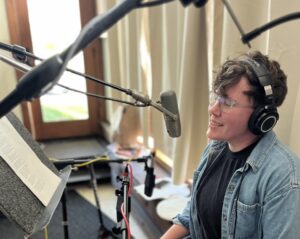Katie Castagno of Eastham has finished the last bits of recording for her album, Our Queer Elders, to be released this summer. The songs are about people in history who have “queered social norms,” she says, and recording them has taken on a new importance. “I’m doing it at a time when I’m seeing queer history actively erased,” she says.

Castagno is a musician, but she doesn’t have an established career as an artist — she works as a coastal geologist at the Center for Coastal Studies in Provincetown. She cobbled together a grant from the Arts Foundation of Cape Cod (AFCC) and funds from Club Passim in Cambridge and the Cordial Eye in Hyannis to pay for studio time at Brick Hill, John Evans’s recording studio in Orleans and for the other musicians. “Recording gets really expensive really fast,” she says.
The story of Castagno’s project helps describe just part of what diversity, equity, and inclusion (DEI) stands for in the artistic realm. Funds that she and seven other “community equity” grantees received from the arts foundation came from a $30,000 match from the National Endowment of the Arts, which announced on Feb. 6 that it was ending its small grant program for underserved groups. Next year, the NEA will instead focus on projects that celebrate the 250th anniversary (semiquincentennial) of the Declaration of Independence.
Applying to AFCC
When it comes to understanding the reach of DEI funding for artists locally, it’s worth noting that all the projects funded last year by the AFCC focused on communities that the organization considers historically underrepresented, including queer people, foreign workers, and people of Indigenous, Caribbean, Hispanic, and Asian ethnicity. Painter James Stanley of Wellfleet received a grant to investigate the history and portrayal of Caribbean diasporic communities in the coastal regions of New England, for example.
Considering the shift in the federal government’s focus, the foundation’s executive director, Julie Wake, is advising applicants to “think about how they’re describing things,” she told the Independent. Framing art projects in terms of diversity, equity, and inclusion is unlikely to be advantageous.
Although AFCC was awarded a grant for fiscal 2025 during the transition between administrations, it has not received the funds yet. It must spend the money and then request reimbursement.
Meanwhile, at the Mass. Cultural Council
Like the AFCC, the Mass. Cultural Council (MCC) offers grants to individual artists. In 2024, the council awarded $5,000 grants to 609 people;16 of those grants went to people in Barnstable County but none to artists on the Outer Cape.
The MCC’s priorities are firmly aimed at equity, and that’s not going to change, according to Michael Bobbitt, who became the council’s executive director in 2021.
Bobbit has been an advocate of making the “creative individual” grant application simpler. “It takes about a half hour to apply,” he says. “We call it applicant-centric grant making. The result is we have thousands more people applying.” Bobbitt criticizes the legacy of “white supremacy culture in grant making” epitomized by cumbersome processes that require financial statements and letters of recommendation from high-profile people.
In pursuit of equity, Bobbitt has also removed consideration of artistic excellence in grants for creative individuals. Whereas the AFCC grant criteria place a 25-percent emphasis on artistic merit, that’s not the case at the MCC, though the application does ask for a description of the applicants’ artistic practice and asks what the work to be supported is trying to express and how it demonstrates a commitment to a creative practice.
With these small grants, “we’re not vetting artistic excellence or trying to make a judgment on the quality of the work,” says Bobbitt. “We’re not a jury prize or private philanthropy. We’re state government, and I can make the case for someone who is struggling, just coming out of school, that their work deserves more funding than someone who’s established and is selling more art.”
With artistic excellence taken out of the equation, equity becomes a central criterion that is assessed in several ways. Geographic diversity is one. MCC also prioritizes demographic groups that may not have had a fair opportunity to be beneficiaries of MCC programs in the past — that includes people who identify as Black, Indigenous, people of color, people with disabilities, people whose creative practice has been limited by poverty, and armed forces veterans.
These plans were developed from grant-making research that looked at where cultural council money was going and who was being left out. Equity plans were not developed for the LGBTQ community or for women because there was no evidence they were underrepresented in the distribution of grants.
MCC’s definition of art has also expanded. “We’ve become more intentionally inclusive of things that are not considered fine art,” says Bobbitt. These grants for creative individuals can be for mentors or apprentices who identify as culture bearers or traditional artists. This can include Native wampum-carving, Russian iconography, or New England sea chanteys.
Since adopting its equity initiatives, MCC has tracked its progress through data and quarterly racial equity progress reports. Its most recent equity report said that 98 percent of eligible Black, Indigenous, and other groups serving people of color received funding.
Early in Bobbitt’s tenure at MCC, the allocation of grants to individuals was not aligned with the state’s demographics. In fiscal 2022, 23 percent of the grants were awarded to applicants who were people of color, although data from 2020 show that around 30 percent of Massachusetts residents were people of color. MCC’s grants from fiscal year 2024 show a different story. Of the 609 grants awarded to creative individuals, 57 percent were awarded to people of color.
Katy Abel contributed reporting.
